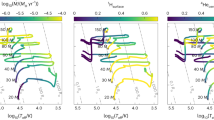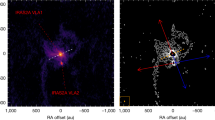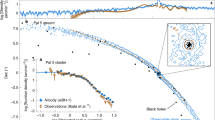Abstract
The formation of very wide binary systems1,2,3, such as the α Centauri system with Proxima (also known as α Centauri C) separated from α Centauri (which itself is a close binary A/B) by 15,000 astronomical units4 (1 au is the distance from Earth to the Sun), challenges current theories of star formation, because their separation can exceed the typical size of a collapsing cloud core. Various hypotheses have been proposed to overcome this problem, including the suggestion that ultrawide binaries result from the dissolution of a star cluster—when a cluster star gravitationally captures another, distant, cluster star5,6,7. Recent observations have shown that very wide binaries are frequently members of triple systems8,9 and that close binaries often have a distant third companion10,11,12. Here we report N-body simulations of the dynamical evolution of newborn triple systems still embedded in their nascent cloud cores that match observations of very wide systems13,14,15. We find that although the triple systems are born very compact—and therefore initially are more protected against disruption by passing stars16,17—they can develop extreme hierarchical architectures on timescales of millions of years as one component is dynamically scattered into a very distant orbit. The energy of ejection comes from shrinking the orbits of the other two stars, often making them look from a distance like a single star. Such loosely bound triple systems will therefore appear to be very wide binaries.
This is a preview of subscription content, access via your institution
Access options
Subscribe to this journal
Receive 51 print issues and online access
$199.00 per year
only $3.90 per issue
Buy this article
- Purchase on Springer Link
- Instant access to full article PDF
Prices may be subject to local taxes which are calculated during checkout




Similar content being viewed by others
References
Bahcall, J. N. & Soneira, R. M. The distribution of stars to V = 16th magnitude near the north galactic pole—normalization, clustering properties, and counts in various bands. Astrophys. J. 246, 122–135 (1981)
Sesar, B., Ivezic, Z. & Juric, M. Candidate disk wide binaries in the Sloan Digital Sky Survey. Astrophys. J. 689, 1244–1273 (2008)
Dhital, S., West, A. A., Stassun, K. G. & Bochanski, J. J. Sloan Low-mass Wide Pairs of Kinematically Equivalent Stars (SLoWPoKES): a catalog of very wide, low-mass pairs. Astron. J. 139, 2566–2586 (2010)
Wertheimer, J. G. & Laughlin, G. Are Proxima and α Centauri gravitationally bound? Astron. J. 132, 1995–1997 (2006)
Kouwenhoven, M. B. N. et al. The formation of very wide binaries during the star cluster dissolution phase. Mon. Not. R. Astron. Soc. 404, 1835–1848 (2010)
Moeckel, N. & Clarke, C. J. The formation of permanent soft binaries in dispersing clusters. Mon. Not. R. Astron. Soc. 415, 1179–1187 (2011)
Moeckel, N. & Bate, M. R. On the evolution of a star cluster and its multiple stellar systems following gas dispersal. Mon. Not. R. Astron. Soc. 404, 721–737 (2010)
Law, N. M., Dhital, S., Kraus, A., Stassun, K. G. & West, A. A. The high-order multiplicity of unusually wide M dwarf binaries: eleven new triple and quadruple systems. Astrophys. J. 720, 1727–1737 (2010)
Faherty, J. M. et al. The brown dwarf kinematics project. II. Details on nine wide common proper motion very low mass companions to nearby stars. Astron. J. 139, 176–194 (2010)
Tokovinin, A., Thomas, S., Sterzik, M. & Udry, S. Tertiary companions to close spectroscopic binaries. Astron. Astrophys. 450, 681–693 (2006)
Tokovinin, A. & Smekhov, M. G. Statistics of spectroscopic sub-systems in visual multiple stars. Astron. Astrophys. 382, 118–123 (2002)
Allen, P. R., Burgasser, A. J., Faherty, J. K. & Kirkpatrick, J. D. Low-mass tertiary companions to spectroscopic binaries. I. Common proper motion survey for wide companions using 2MASS. Astron. J. 144, 62 (2012)
Chanamé, J. & Gould, A. Disk and halo wide binaries from the revised Luyten Catalog: probes of star formation and MACHO dark matter. Astrophys. J. 601, 289–310 (2004)
Lépine, S. & Bongiorno, B. New distant companions to known nearby stars. II. Faint companions of Hipparcos stars and the frequency of wide binary systems. Astron. J. 133, 889–905 (2007)
Tokovinin, A. & Lépine, S. Wide companions to HIPPARCOS stars within 67 pc of the Sun. Astron. J. 144, 102 (2012)
Retterer, J. M. & King, I. R. Wide binaries in the solar neighborhood. Astrophys. J. 254, 214–220 (1982)
Weinberg, M. D., Shapiro, S. L. & Wasserman, I. The dynamical fate of wide binaries in the solar neighborhood. Astrophys. J. 312, 367–389 (1987)
Goodwin, S. P., Kroupa, P., Goodman, A. & Burkert, A. in Protostars and Planets V (eds Reipurth B., Jewitt, D. & Keil, K.) 133–147 (Univ. of Arizona Press, 2007)
Dûchene, G., Delgado-Donate, E., Haisch, K. E., Loinard, L. & Rodríguez, L. F. in Protostars and Planets V (eds Reipurth B., Jewitt, D. & Keil, K.) 379–394 (Univ. of Arizona Press, 2007)
Anosova, J. P. Dynamical evolution of triple systems. Astrophys. Space Sci. 124, 217–241 (1986)
Delgado-Donate, E. J., Clarke, C. J., Bate, M. R. & Hodgkin, S. T. On the properties of young multiple stars. Mon. Not. R. Astron. Soc. 351, 617–629 (2004)
Valtonen, M. & Mikkola, S. The few-body problem in astrophysics. Ann. Rev. Astron. Astrophys. 29, 9–29 (1991)
Reipurth, B., Mikkola, S., Connelley, M. & Valtonen, M. Orphaned protostars. Astrophys. J. 725, L56–L61 (2010)
Reipurth, B. Disintegrating multiple systems in early stellar evolution. Astron. J. 120, 3177–3191 (2000)
Mardling, R. A. The Cambridge N-body Lectures (eds Aarseth, S. J., Tout, C. A. & Mardling, R. A.) 59–96 (Springer, 2008)
Tokovinin, A. in Multiple Stars Across the H-R Diagram (eds Hubrig, S., Petr-Gotzens, M. & Tokovinin, A.) 38–42 (Springer, 2008)
Korntreff, C., Kaczmarek, T. & Pfalzner, S. Towards the field binary population: influence of orbital decay on close binaries. Astron. Astrophys. 543, A126 (2012)
Teixeira, R. et al. SSSPM J1102–3431 brown dwarf characterization from accurate proper motion and trigonometric parallax. Astron. Astrophys. 489, 825–827 (2008)
Kastner, J. H. et al. 2M1155–79 ( = T Chamaeleontis B): A low-mass, wide-separation companion to the nearby “old” T Tauri Star T Chamaeleontis. Astrophys. J. 747, L23 (2012)
Longhitano, M. & Binggeli, B. The stellar correlation function from SDSS. A statistical search for wide binary stars. Astron. Astrophys. 509, A46 (2010)
Acknowledgements
We thank C. J. Clarke, M. B. N. Kouwenhoven and A. Tokovinin for comments. B.R. thanks the European Southern Observatory and Tuorla Observatory for hospitality during the period when this paper was written, and H.-F. Chiang and C. Aspin for providing additional computer facilities. This work was supported by the National Aeronautics and Space Administration through the NASA Astrobiology Institute under Cooperative Agreement number NNA09DA77A issued through the Office of Space Science. This research has made use of the SIMBAD database, operated at Centre de Données astronomiques de Strasbourg, Strasbourg, France, and of NASA’s Astrophysics Data System Bibliographic Services.
Author information
Authors and Affiliations
Contributions
B.R. conceived the idea, carried out the simulations and data analysis, and wrote the paper. S.M. developed the code and wrote the software tools for analysis.
Corresponding author
Ethics declarations
Competing interests
The authors declare no competing financial interests.
Supplementary information
Supplementary Information
This file contains Supplementary Text and Data 1-11, Supplementary Figure 1 and additional references. (PDF 243 kb)
Rights and permissions
About this article
Cite this article
Reipurth, B., Mikkola, S. Formation of the widest binary stars from dynamical unfolding of triple systems. Nature 492, 221–224 (2012). https://doi.org/10.1038/nature11662
Received:
Accepted:
Published:
Issue Date:
DOI: https://doi.org/10.1038/nature11662
This article is cited by
-
Discovery of two rotational modulation periods from a young hierarchical triple system
Science China Physics, Mechanics & Astronomy (2023)
-
Detection of wide binary and multiple nuclei of planetary nebulae using the Gaia DR3
Astrophysics and Space Science (2023)
-
One family of 13315 stable periodic orbits of non-hierarchical unequal-mass triple systems
Science China Physics, Mechanics & Astronomy (2021)
-
The Origin of the Stellar Mass Distribution and Multiplicity
Space Science Reviews (2020)
-
The formation of a quadruple star system with wide separation
Nature (2015)
Comments
By submitting a comment you agree to abide by our Terms and Community Guidelines. If you find something abusive or that does not comply with our terms or guidelines please flag it as inappropriate.



